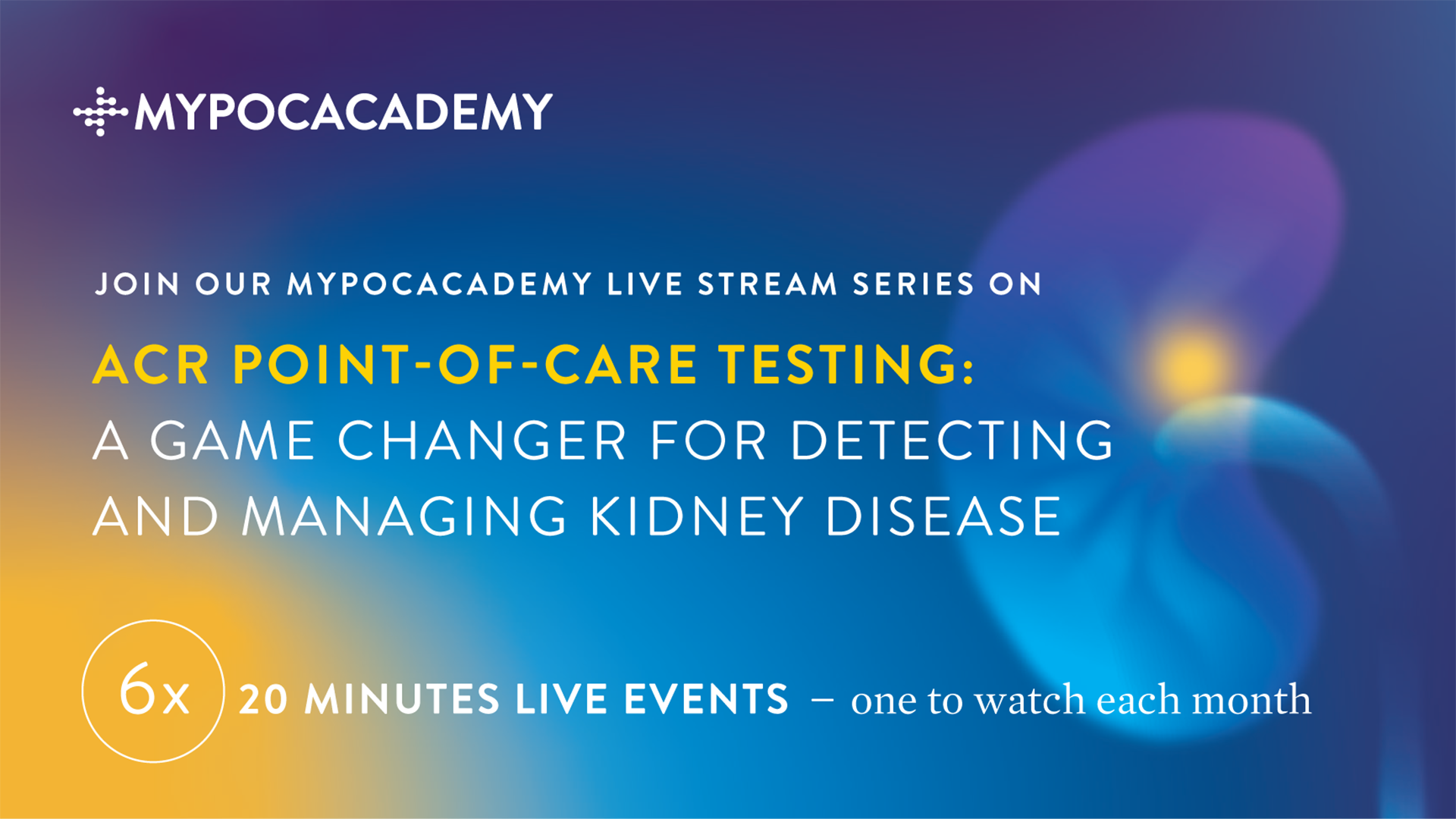
Abbott outlines how albumin-to-creatinine ratio measurement can be leveraged to address the increasing global burden of kidney disease.
Albumin-to-creatinine ratio (ACR) is known to be the earliest marker of kidney disease.1 Despite this, the frequency of ACR testing remains low.2-4 Early identification and management of kidney disease – through the use of new medications and methods such as ACR point-of-care testing – can slow disease progression and even prevent it.5 Given that ACR is also associated with cardiovascular morbidity and all-cause mortality,1,2,4-6 this article looks at how ACR measurement can be leveraged to address the increasing global burden of kidney disease.
The impact of kidney disease
Approximately 8–16% of the adult population have kidney damage, and every year millions die of complications related to chronic kidney disease (CKD).7
Worldwide, the estimated number of people with CKD has grown in proportion to the rising prevalence of diabetes, driven largely by obesity, a sedentary lifestyle, an epidemic of type 2 diabetes, and an increasing incidence of type 1 diabetes.8 For people with diabetes, CKD is a potentially devastating condition leading to kidney failure requiring dialysis or a kidney transplant.5
Kidney disease is associated with significant additional health expenditure for people with diabetes.1 Based on a US study conducted between 1999 and 2002, people with diabetes, but no nephropathy, incurred a mean annual medical cost of $4,573, while patients with clinical nephropathy experienced mean annual costs 49% higher.1 Moreover, when nephropathy progresses to end-stage renal disease (ESRD) the associated health expenditures increase exponentially.1
Cardiovascular risk and kidney disease
Kidney disease is also closely associated with an increased risk of cardiovascular events and mortality.3,6,7 The aetiology of CKD is multifactorial, with glomerular hypertension and hyperfiltration contributing to disease progression.7 Both systemic hypertension and glomerular hypertension are known to provoke injury to the glomeruli.7 As a consequence, elevated blood pressure can overwhelm normal protection afforded from systemic hypertension to the kidney by autoregulation.7 Hyperfiltration initiates the renin-angiotensin-aldosterone system (RAAS), which in turn, increases glomerular permeability and gives rise to albuminuria, proteinuria and dyslipidemia, while also diminishing glomerular filtration rate (GFR).
Kidney disease is typically characterised by persistent albuminuria, increasing serum creatinine and a progressive decline in estimated GFR (eGFR).1,8,9 Over time, worsening CKD is associated with an increased risk of cardiovascular and cerebrovascular events, as well as renal morbidity and mortality.7,5
Addressing clinical gaps
To reduce the burden of kidney disease, the most effective strategy is to diagnose and treat CKD early on.1 Starting early, therapy can lead to important improvements in clinical outcomes for patients and cost savings when compared with a later start of the same intervention.1 A lower albumin-to-creatinine ratio value achieved through therapy is associated with improved protection of the kidneys (renoprotection).10 Slowing down CKD progression in the early stages prevents the development of ESRD and cardiovascular complications.11
For this reason, clinical guidelines have recommended screening for albuminuria and starting treatment when albuminuria is persistently found, even in the absence of hypertension.1,6 More recent guidelines recommend multiple interventions to optimise the care of people with diabetes and CKD, and state that it is crucial to avoid therapeutic inertia.6,12,13 Most patients with diabetes and CKD have high risks of CKD progression and cardiovascular disease, despite treatment, and increasing options are available for risk mitigation.6,12,13 These currently include RAAS inhibitors, sodium/glucose cotransporter-2 (SGLT2) inhibitors, glucagon-like peptide 1 (GLP1) receptor agonists, and the nonsteroidal mineralocorticoid receptor antagonist (ns-MRA) finerenone, all of which cause initial hemodynamic reductions in GFR.12,13 When indicated, such medications need frequent assessments to optimise care, including regular monitoring of albumin-to-creatinine ratio.12
CKD is currently under-recognised by both patient and provider.3,4 Guidelines recognise albuminuria as central to CKD staging and provide criteria for referral to a nephrologist.3,4 However, albuminuria monitoring and nephrologist referral are low.3,4 This is in contrast to the increasing number of effective treatments for preventing CKD-related complications.4,12 Overall, there is a considerable gap between CKD diagnosis, staging and referral patterns, and recent clinical practice guidelines, highlighting areas for improvement in this setting.3,4
Early diagnosis using ACR point-of-care testing
Albuminuria often represents the first sign of kidney damage and precedes a decline in GFR.1,14-16 For the diagnosis of diabetic kidney disease (DKD), ACR measurement is recommended according to various guidelines.6,8,12,13 It can be measured either in specialised laboratories or using POCT.16 The latter method delivers accurate albumin-to-creatinine ratio results and has several advantages. It is conducted rapidly, results are received within minutes, and it has high satisfaction and acceptability for the patient.16 Furthermore, it is likely cost-saving for the office/hospital.16 The implementation of POCT optimises working processes, and the immediate availability of POCT results is associated with the same or improved medication adherence compared with laboratory-provided test results.16 POCT also has value in remote or resource-limited settings.17
A recent observational study evaluated the effect of ACR POCT utilisation on DKD diagnosis and treatment management for glycaemic control and blood pressure.16 Of all participants, 39.1% had a confirmed/suspected DKD diagnosis, 8.6% were newly diagnosed, and 9.9% were suspected of having DKD based on the actual ACR POCT values.16 Within the group of patients with confirmed/suspected DKD, treatment modification was performed in 46.1% of participants.16 A drug initiation with GLP1 receptor agonists was performed in 11.1% and with SGLT inhibitors in 8.9% of patients with confirmed/suspected DKD, respectively.16 The authors concluded that implementation of albumin-to-creatinine ratio POCT may positively affect diagnosis and subsequently allow better management of patients with diabetes16
Practice-based improvement in prevention, recognition and treatment
A recent registry-based US cohort study looking at CKD highlighted the critical need for quality improvement and research at the point of care.18 Although nearly two-thirds of the adults included in the study had diabetes, hypertension or prediabetes, rates of laboratory testing for albuminuria or proteinuria and prescribing angiotensin-converting enzyme (ACE) inhibitors or angiotensin receptor blockers (ARBs) were low.18 Potentially nephrotoxic agents were used more commonly than RAAS inhibitors.18
Although contrasts existed between reports from different healthcare systems, community screenings, primary care practices, and countries, major gaps were found in CKD care throughout, and the need for more comprehensive surveillance was identified.18
The registry study also revealed a burgeoning number of patients with CKD and major risk factors of diabetes, hypertension and prediabetes.18 Rates of identification and use of kidney protective agents were low, while nephrotoxin use was widespread, underscoring the pressing need for practice-based improvement in CKD prevention, recognition and treatment.18 The authors conclude that there is a need to develop more effective strategies to deliver care that enhances wellness and survival for patients with and at risk for CKD.18
An individual-participant data meta-analysis in a global consortium also found albumin-to-creatinine ratio screening rates are extremely low in both diabetes (35%) and hypertension (4%), and current testing is not targeted toward the highest-risk individuals.4 With an increasing number of effective therapies to prevent CKD complications, there is a substantial opportunity to improve early diagnosis of CKD for better use of these agents in the population with diabetes or hypertension.4 This will lead to cardiovascular and renal benefits for this patient group.4
Implementing multi-parameter POCT into primary care
In resource-limited or remote settings, POCT can offer a distinct benefit over laboratory testing.3,17,19-21 Several point-of-care devices are now available which combine ACR measurement with other useful measures (HbA1c, lipid profiles etc).20,21
Whilst the implementation of ACR POCT may positively affect the diagnosis of kidney disease and subsequently allow better management of diabetic patients,20 the ‘one-stop-shop’ concept for POCT is of value to healthcare professionals who require immediate access to a wide array of test parameters.20
Upcoming webcast series on point-of-care ACR testing
ACR POCT is discussed in detail in the webcast mini-series on the educational platform myPOCacademy.com; an online resource with Continuing Professional Development (CPD) certified content.
International speakers consider the role of rapid diagnostics in disease prevention, explaining how ACR POCT enables healthcare providers to detect, and initiate treatment for kidney disease in minutes. The first three of these six 20-minute webcasts – one to watch each month – is now available to watch on-demand (for free) here.
Register for myPOCacademy here (or via the QR code below) and receive alerts as soon as registration for the remaining events opens.
Make sure you fill out the feedback form after watching to obtain your CPD certificate.
The myPOCacademy learning platform
The Abbott educational platform myPOCacademy is an expert resource for healthcare professionals, providing a range of professionally certified learning on POCT. Working with an expert faculty, content covers multiple clinical disciplines, including respiratory health, kidney and cardiovascular disease, infectious disease and diabetes.
You can learn more about the platform by watching the introductory video or by registering at www.myPOCacademy.com. Content can be accessed by registering for free.
© 2023 Abbott. All rights reserved. All trademarks referenced are trademarks of either the Abbott group of companies or their respective owners. Any photos displayed are for illustrative purposes only. COL-19147 02/2023



References
- International Diabetes Federation. Diabetes Atlas 8th Edition. 2017; available at: https://diabetesatlas.org/upload/resources/previous/files/8/IDF_DA_8e-EN-final.pdf
- Bakke, et al. Type 2 diabetes in general practice in Norway 2005–2014: moderate improvements in risk factor control but still major gaps in complication screening. BMJ Open Diab Res Care. 2017;5:e000459
- Gasparini, et al. Prevalence and recognition of chronic kidney disease in Stockholm healthcare. Nephrol Dial Transplant. 2016;31(12):2086-2094
- Shin, et al. Albuminuria testing in hypertension and diabetes: an individual-participant data meta-analysis in a global consortium. Hypertension. 2021;78(4):1042-1052
- International Society of Nephrology and the International Federation of Kidney Foundations. World Kidney Day. Chronic kidney disease. Available at: https://www.worldkidneyday.org/facts/chronic-kidney-disease/
- KDIGO Diabetes Work Group. KDIGO 2022 clinical practice guideline for diabetes management in chronic kidney disease. Kidney Int. 2022;102(5S):S1-S127
- Norris, et al. Albuminuria, serum creatinine, and estimated glomerular filtration rate as predictors of cardio-renal outcomes in patients with type 2 diabetes mellitus and kidney disease: a systematic literature review. BMC Nephrol. 2018;19:36
- KDIGO. Kidney Disease Improving Global Outcomes 2020 clinical practice guideline for diabetes management in chronic kidney disease. Kidney Int. 2020;98(4S):S1-S115
- Sundstrom, et al. Prevalence, outcomes, and cost of chronic kidney disease in a contemporary population of 2.4 million patients from 11 countries: The CaReMe CKD study. 2022;20:100438
- Cosentino, et al. 2019 ESC Guidelines on diabetes, pre-diabetes, and cardiovascular diseases developed in collaboration with the EASD. Eur Heart J. 2020;41(2):255-323
- GBD Chronic Kidney Disease Collaboration. Global, regional, and national burden of chronic kidney disease, 1990-2017: a systematic analysis for the global burden of disease study 2017. Lancet. 2020;395(10225):709-733
- de Boer, et al. Diabetes management in chronic kidney disease: a consensus report by the American Diabetes Association (ADA) and Kidney Disease: Improving Global Outcomes (KDIGO). Diabetes Care. 2022;45(12):3075-3090
- American Diabetes Association. Standards of medical care in Diabetes 2023. Available at: https://diabetesjournals.org/care/issue/46/Supplement_1
- Persson, et al. Diagnosis of diabetic kidney disease: state of the art and future perspective. Kidney Int Suppl. 2018;8(1):2-7
- Pugliese, et al. Diabetic kidney disease: new clinical and therapeutic issues. Joint position statement of the Italian Diabetes Society and the Italian Society of Nephrology on “the natural history of diabetic kidney disease and treatment of hyperglycemia in patients with type 2 diabetes and impaired renal function.” J Nephrol. 2020;33(1):9-35
- Schultes, et al. Impact of albumin-to-creatinine ratio point-of-care testing on the diagnosis and management of diabetic kidney disease. J Diabetes Sci Technol. 2023;17(2):428-438
- Currin, et al. Diagnostic accuracy of semiquantitative point of care urine albumin to creatinine ratio and urine dipstick analysis in a primary care resource-limited setting in South Africa. BMC Nephrol. 2021;22(1):103
- Tuttle, et al. Clinical characteristics of and risk factors for chronic kidney disease among adults and children: an analysis of the CURE-CKD registry. JAMA Netw Open. 2019;2(12):e1918169
- Crocker, et al. Implementation of point-of-care testing in an ambulatory practice of an academic medical center. Am J Clin Pathol. 2014;142(5):640-6
- Jain, et al. Evaluation of the point of care Afinion AS100 analyser in a community setting. Ann Clin Biochem. 2017;54(3):331-341
- Lenters-Westra, et al. Analysis: Investigating the quality of POCT devices for HbA1c, what are our next steps? J Diabetes Sci Technol. 2019;13(6):1154-1157
This article is from issue 25 of Health Europa Quarterly. Click here to get your free subscription today.








